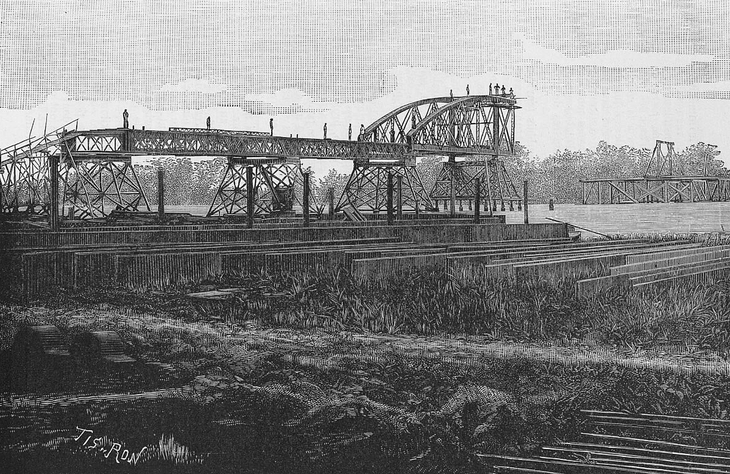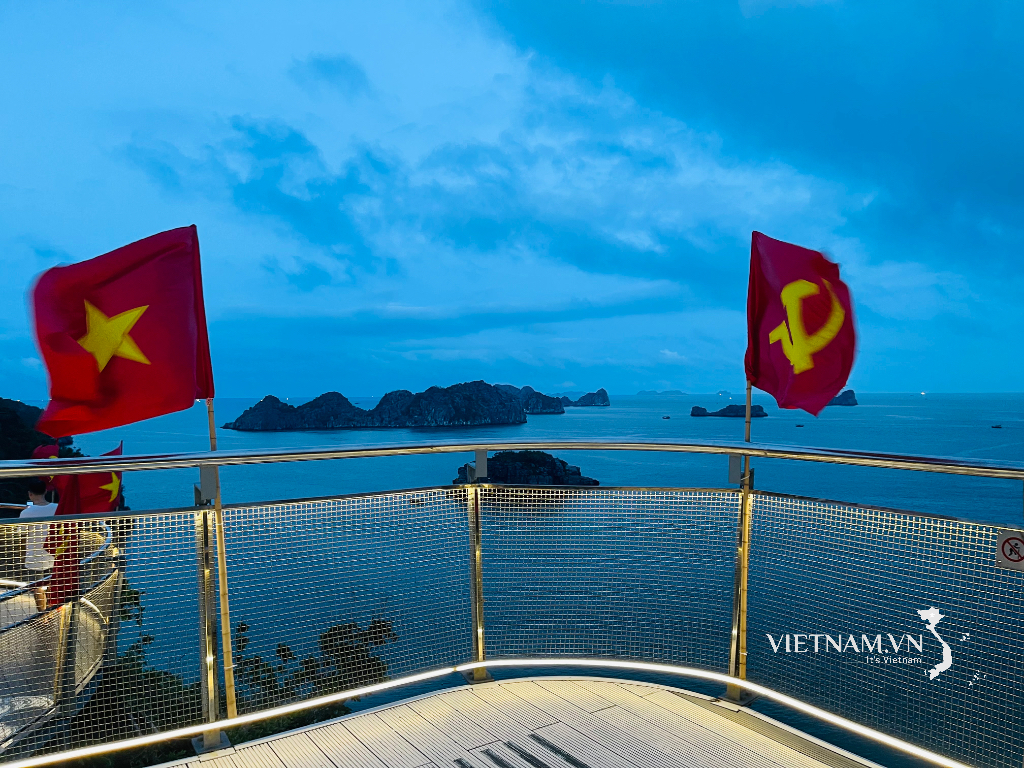My Tho Station. Source: M. Pierre Nicolas (1900)
The concept, which seemed to exist only in distant stories, quickly became a reality. In just a few years, the trains on the Saigon - My Tho railway changed the pace of life in Saigon and the West , paving the way for urbanization and trade flows.
Construction: The struggle between swamp and bridge
Since 1874, the first drafts of the railway appeared, but immediately caused controversy. The project to connect Saigon with Phnom Penh via Tay Ninh was considered "luxury" and "unrealistic" (according to a document called Procès - verbaux du Conseil coloniale in 1880).
After many rounds of debate and rebuttal, the authorities were forced to choose the shortest, lowest risk and most suitable cost option: the route from Saigon - the capital of Cochinchina to My Tho - the commercial center of the West.
The railway line is about 70km long. This is an "easy investment, quick return" project in the eyes of the French government.
Although much shorter in both length and purpose, the Saigon - My Tho route was still the largest-scale transport project in Vietnam at that time.
In 1881, the French government signed a 99-year concession contract with engineer Joret, a contractor from Paris, to build and operate the Saigon - My Tho railway. According to the agreement, the government was responsible for the roadbed and bridges, while Joret was responsible for the tracks, locomotives and warehouses. The construction was to be completed before December 31, 1883.
That said, when it comes to actually doing it, all the difficulties immediately appear.
From Saigon to My Tho at that time, it was almost just mud and a tangle of canals, with water rising and falling seasonally, making construction always at risk of landslides and subsidence. To keep the railway from sinking into the weak soil, engineers had to build hundreds of thousands of cubic meters of earth, reinforce the foundation with wood, drive deep piles and divide the entire line into dozens of small construction sections.
This was the first railway in Indochina, so there was a lack of materials, machinery and almost no technical experience.
The most difficult part was the bridge construction. According to Les voies de communication en Indochine (author Gentilini. R., 1886), in the original design, the railway would run through 16 small steel bridges, 5 medium steel bridges and 3 large steel bridges, of which the three large bridges Ben Luc, Tan An, Binh Dien were entrusted to the G. Eiffel Company.
This was a real struggle for both engineers and workers. The 97.2m long Binh Dien Bridge was fortunately completed in 1883, but the 342m long Ben Luc Bridge and the 227m long Tan An Bridge continued to run up costs and change designs. At one point, the contractor even abandoned construction due to financial disputes. The project was therefore twice as slow as planned.
Finally, after more than four years of struggling in the swamps of Cochinchina, the Saigon - My Tho route was completed, but with a total cost exceeding the estimate by about 2 million francs.
The first trains, cheaper fares than waterways
July 20, 1885 marked a historic moment: the train from Saigon to My Tho officially rolled out.
The sound of the train whistle, the white smoke rising between the fields and the iron train rushing at an unprecedented speed, became a memorable image in the minds of many people at that time.
The railway operates four trips per day. In addition to the Saigon and My Tho stations at both ends of the line, there are 18 stops including two main stations, 11 substations and five stops.
Because the fare is cheaper than water travel and the travel time is shorter, the railway quickly attracts passengers. Moreover, people also travel by train because they are curious to experience the feeling of sitting in an "iron dragon".
From Saigon to My Tho it takes only 2 hours by passenger ship and 3 hours by cargo ship, instead of more than 12 hours by boat - a very significant change.
It can be said that, at that time, taking the train was an event.
Once the railway was operational, making a profit became a nightmare for both the concessionaire and the government. The reason was that operating costs were too high: maintaining bridges, hiring workers, buying fuel, repairing the track were all expensive. Meanwhile, revenue was very low, especially from freight transport, which was considered the main goal.
Contractor Joret continuously complained of losses while the government "accused" the contractor of slow construction, poor quality, and increased costs. The two sides argued endlessly. In 1888, after a difficult period of operation, Joret officially "gave up" and returned the line to the government. Not interested in taking over, the government tried to transfer the railway to the Cochinchina Steam Railway Company. However, the situation did not improve much.
After much debate, the reason for the railway's losses was attributed to the over-development of waterways. The West was mainly used for waterway traffic, where boats and ships could operate continuously day and night without the need for transshipment. On the contrary, the railway had to unload goods at both ends of the station, which was both time-consuming and increased costs.
So while the number of passengers on the train increased, the number of goods transported was very small. This railway line accidentally became the "express bus line" during the French colonial period.
However, many times, the idea of extending the route to Vinh Long , Can Tho , or connecting Saigon with Phnom Penh has been raised. But all of them just stopped at the drawing board. Lack of budget, low efficiency and poor competitiveness caused all plans to be shelved.
By 1912, the Saigon - My Tho railway officially returned to the control of the colonial government.
Tan An Bridge under construction on July 24, 1883. Source: Gentilini (1886)
Legacy
Despite its commercial failure, the Saigon - My Tho railway still holds a special place in the history of our country's transportation. It was the first railway line built in Vietnam, marking the transition from traditional to modern transportation.
The birth of this railway also promoted the development of the areas along the railway. Many new occupations appeared, from road workers, mechanics to station staff and small traders around the railway. More importantly, the route created the premise for the expansion of the Vietnamese railway system in the 20th century.
After more than a hundred years of historical changes, Vietnam's first railway line now only remains in memory. However, the story of the Saigon - My Tho railway line is not only the story of a route, of the appearance of traffic in the South during the colonial period, but more broadly, it is also the story of the changes in the South when entering the path of modernization.
Tuoitre.vn
Source: https://tuoitre.vn/ky-uc-ve-tuyen-duong-sat-dau-tien-o-viet-nam-sai-gon-my-tho-20251109150104752.htm





![[Photo] Prime Minister Pham Minh Chinh chairs a meeting on housing policy and the real estate market.](https://vphoto.vietnam.vn/thumb/1200x675/vietnam/resource/IMAGE/2025/11/11/1762838719858_dsc-2107-jpg.webp)
![[Photo] Chu Noodles - the essence of rice and sunshine](https://vphoto.vietnam.vn/thumb/1200x675/vietnam/resource/IMAGE/2025/11/11/1762846220477_ndo_tl_7-jpg.webp)





















































































![Dong Nai OCOP transformation: [Article 4] Reaching national standard products](https://vphoto.vietnam.vn/thumb/402x226/vietnam/resource/IMAGE/2025/11/11/1762825820379_4702-cac-san-pham-trai-cay-chung-nhan-ocop-nongnghiep-174649.jpeg)



![Dong Nai OCOP transition: [Article 3] Linking tourism with OCOP product consumption](https://vphoto.vietnam.vn/thumb/402x226/vietnam/resource/IMAGE/2025/11/10/1762739199309_1324-2740-7_n-162543_981.jpeg)






Comment (0)